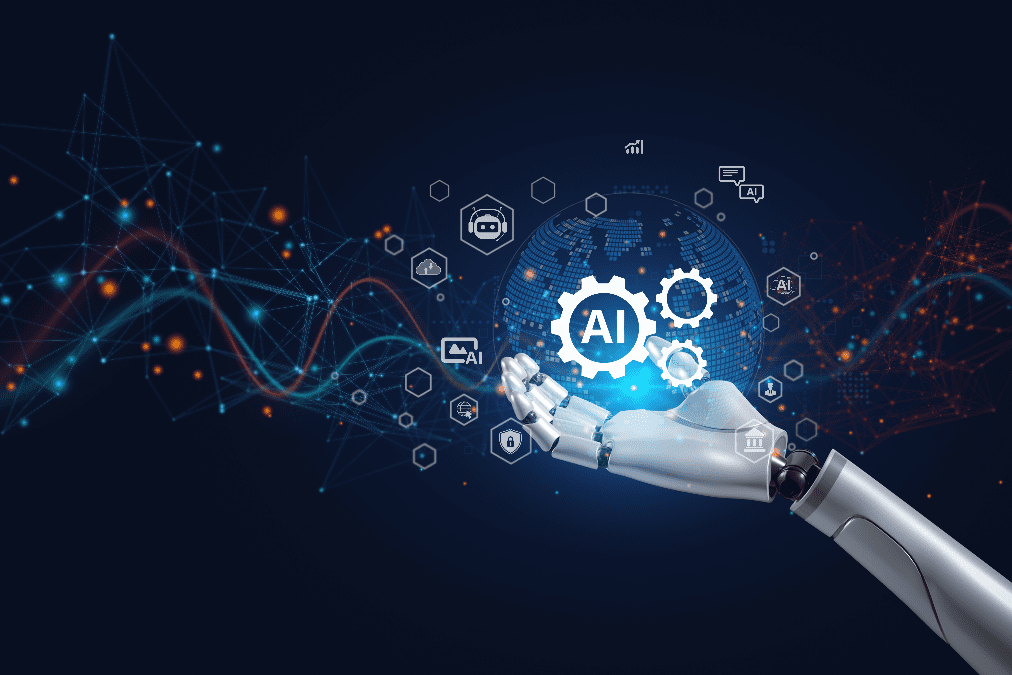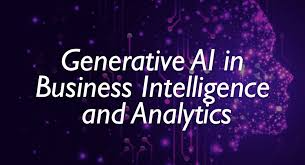For years, business intelligence tools have served as the backbone of data-driven decision-making. Traditionally, these platforms have enabled users to visualize trends, monitor performance metrics, and generate static reports—primarily through predefined queries and dashboards. However, as data volumes grow and market dynamics become more volatile, businesses are demanding more intelligent, adaptive solutions. The expectation now goes beyond descriptive reporting; decision-makers want real-time, predictive, and conversational analytics that deliver actionable insights instantly.
The integration of generative AI into modern business intelligence software is reshaping the landscape of analytics. By harnessing the capabilities of artificial intelligence in business environments, organizations are moving from reactive reporting to proactive strategy development. Whether in finance, retail, or supply chain operations, this technological shift allows users to interact with their data in natural language, automate complex analyses, and simulate future scenarios—all within their existing business BI environments.
This article explores how the fusion of generative AI and business intelligence tools is revolutionizing the way companies extract and utilize data. It examines the emerging capabilities, practical use cases, and strategic advantages of combining AI for business applications with today’s best BI tools. Through this lens, we aim to illuminate how forward-thinking enterprises can unlock new levels of efficiency, agility, and competitive intelligence with the next generation of business analytics software.

Overview of Business Intelligence Tools
Business intelligence refers to the technologies, processes, and tools that help organizations collect, analyze, and visualize data to support better decision-making. At its core, a business intelligence platform transforms raw data into meaningful insights through dashboards, KPIs, visualizations, and interactive reports. These business intelligence tools have long been central to monitoring performance, identifying trends, and driving strategic initiatives across departments—from marketing and operations to finance.
Commonly used business intelligence software includes platforms such as Microsoft Power BI, Tableau, Qlik, and Google Looker. These tools are often considered among the best BI tools on the market due to their ease of use, strong integration capabilities, and broad adoption across industries. They allow users to build reports, create real-time dashboards, and access data from multiple sources, supporting a range of business analytics software needs.
However, despite their capabilities, traditional BI tools come with notable limitations. Much of business intelligence reporting still relies on static charts and predefined queries, often requiring technical expertise to generate meaningful insights. Forecasting is generally limited to historical trend projections, lacking the adaptability required for real-time decision-making in dynamic markets. Manual data exploration processes can also slow down the ability of business teams to respond quickly to emerging opportunities or risks.
As businesses increasingly embrace digital transformation, the need for more advanced, intuitive, and predictive tools is growing. This is particularly evident in areas like AI in finance, where complex data patterns must be understood in real time. To meet this demand, companies are beginning to augment their business intelligence tools with artificial intelligence in business applications—most notably, through the integration of generative AI. This evolution is redefining the role of BI from a static reporting tool to an intelligent assistant that can anticipate needs, suggest actions, and empower users at all levels of the organization.
What is Generative AI?
Generative AI is a branch of artificial intelligence in business and technology that focuses on creating new content, insights, or data patterns based on existing information. Unlike traditional AI systems that follow predefined rules, generative AI uses advanced machine learning models to produce original outputs—whether it’s text, images, simulations, or predictive scenarios. At the heart of this technology are Large Language Models (LLMs), such as those developed by OpenAI, and increasingly powerful multimodal models capable of understanding and generating content across text, audio, and visual formats.
In the context of business intelligence tools and platforms, generative AI introduces a new level of adaptability and user interaction. It allows users to engage with their data using natural language, removing the technical barriers often associated with traditional business intelligence software. With generative AI embedded in business analytics software, business users can now ask complex questions like “Why did revenue dip in Q2?” or “Simulate the impact of a 10% increase in operational costs,” and receive contextualized, insightful responses.
Some of the key capabilities of generative AI that are transforming business BI include:
Text Generation: Automatically crafting narratives and summaries from raw data, turning numbers into actionable stories.
Summarization: Condensing large datasets or reports into executive-ready briefs, useful across roles and industries, especially in AI in finance and strategic planning.
Natural Language Querying: Enabling users to interact with their business intelligence tools conversationally—no SQL or coding required.
Scenario Simulation: Running “what-if” analyses that model different business outcomes, enhancing forecasting accuracy and decision-making confidence.
Automated Insights: Identifying trends, anomalies, and opportunities within complex data without manual analysis, making business intelligence reporting faster and more insightful.
By integrating these generative capabilities into modern business intelligence platforms, organizations are reimagining what’s possible with their data. This fusion of AI for business and analytics is not only making insights more accessible, but also empowering teams to move from reactive decision-making to proactive, strategy-driven execution.
Integration of Generative AI into BI Tools
The integration of generative AI into modern business intelligence tools marks a significant leap forward in how organizations interact with their data. Traditionally, extracting insights from business intelligence software required structured queries, technical know-how, and manual effort. Now, with the rise of AI for business applications, these barriers are being dismantled, giving way to more intuitive, responsive, and automated data analysis experiences.

Natural Language Interfaces
One of the most transformative features generative AI brings to business intelligence platforms is the ability to interact with data using natural language. Instead of relying on technical syntax or predefined filters, users can simply ask questions like “What were our top-selling products last quarter?” or “How did marketing ROI change year over year?” This conversational interface lowers the entry barrier to data exploration, making business BI more accessible to non-technical teams across sales, marketing, and operations. It aligns with the growing demand for user-friendly business analytics software that empowers everyone—not just analysts—to make data-driven decisions.
Automated Report Generation
Generative AI can dynamically generate written narratives and executive summaries based on dashboard data or custom queries. This capability goes far beyond standard business intelligence reporting by translating charts and tables into contextualized, human-readable insights. Whether used for weekly sales updates, financial reviews, or operational performance summaries, automated report generation helps save time, reduce human error, and ensure consistent messaging across the organization.
Scenario Modeling & Forecasting
Another major advancement lies in scenario modeling and predictive analytics. Generative models can simulate various business outcomes—such as changes in pricing, customer behavior, or supply chain disruptions—and instantly show potential impacts. This is especially powerful in sectors like AI in finance, where accurate forecasting is critical. By integrating generative AI into business intelligence tools, companies gain the ability to perform rapid “what-if” analyses, test hypotheses, and plan more strategically in real time.
Data Exploration & Querying
Generative AI also enhances the way users explore data within business intelligence platforms. Instead of manually slicing datasets or running multiple queries, AI can proactively suggest insights, identify anomalies, or recommend deeper drill-downs based on patterns it detects. This intelligent guidance transforms business BI from a passive tool into an active partner in data analysis, unlocking more value from every dataset and reducing the time needed to uncover actionable findings.
As generative AI becomes embedded in the best BI tools, the line between data analytics and decision-making continues to blur. The result is a new class of artificial intelligence in business—one that combines human intuition with machine intelligence to deliver faster, smarter, and more adaptive insights across the enterprise.
Benefits of Integration
The integration of generative AI into business intelligence tools delivers transformative benefits that extend across the entire organization. By combining the advanced capabilities of artificial intelligence in business environments with the power of modern business analytics software, companies are unlocking new levels of accessibility, speed, and strategic insight. These benefits are reshaping the expectations of what business intelligence platforms can deliver—especially in competitive, data-rich industries like finance, retail, and logistics.
Increased Accessibility
Perhaps the most immediate advantage is the democratization of data analysis. With generative AI embedded into business intelligence software, non-technical users can now access, understand, and act on data without relying on analysts or IT teams. By allowing users to query data through simple, natural language prompts, these AI-enhanced business BI tools remove the technical barriers that traditionally limited data-driven decision-making to a small group of experts. This opens up the use of business intelligence reporting across departments, encouraging a more data-literate workforce.
Faster Decision-Making
Generative AI dramatically shortens the time it takes to turn data into decisions. Rather than waiting for manually prepared reports or navigating complex dashboards, users can receive AI-generated insights instantly in response to specific business questions. In fast-paced environments—such as AI in finance, where split-second decisions can impact risk and return—this ability to extract real-time insights is a game-changer. The result is a more agile organization capable of responding quickly to both opportunities and threats.
Enhanced Customization
One of the standout features of generative AI in business intelligence tools is the ability to tailor reports and dashboards to individual users or roles. By understanding the intent behind conversational prompts, AI can deliver highly personalized outputs—whether it’s a custom sales report for a regional manager or a visual forecast tailored for a CFO. This level of customization not only improves user experience but also ensures that stakeholders receive insights that are directly relevant to their needs and responsibilities.
Improved Forecasting & Planning
Generative AI elevates the forecasting capabilities of business intelligence platforms by simulating future scenarios and identifying trends that might otherwise go unnoticed. With predictive analytics powered by AI for business, organizations can better anticipate market changes, customer behavior, and operational risks. These forecasting enhancements are particularly valuable in strategic planning, where accurate projections are critical to setting goals, allocating resources, and maintaining a competitive edge.
Together, these benefits signal a major shift in how organizations think about and use business intelligence. By integrating generative AI into the best BI tools, companies are not just making data more useful—they’re making it more powerful, more intuitive, and more central to every business decision.
Challenges and Considerations
While the integration of generative AI into business intelligence tools offers substantial advantages, it also introduces new challenges that organizations must carefully manage. As with any transformative technology, the combination of AI for business and traditional business intelligence software requires thoughtful implementation, governance, and ongoing evaluation. Understanding these challenges is essential for realizing the full potential of AI-enhanced business intelligence platforms while mitigating risks.
Data Privacy & Security
One of the foremost concerns when deploying artificial intelligence in business environments is data privacy and security. Business intelligence tools often work with sensitive data—such as financial records, customer information, or proprietary performance metrics. Introducing generative AI models, which may involve cloud-based processing or external APIs, raises the risk of data exposure, especially if proper safeguards are not in place. Organizations must ensure that any integration with generative AI complies with data protection regulations, and that business analytics software is configured with strict access controls, encryption, and audit trails.
Model Accuracy & Reliability
Generative AI models, including large language models, are known to occasionally produce outputs that are factually incorrect or misleading—a phenomenon known as “hallucination.” In the context of business intelligence reporting, such inaccuracies can lead to flawed analyses and poor decision-making. Ensuring the reliability of AI-generated insights is therefore critical. Organizations must implement validation mechanisms, such as cross-checking generated outputs against source data, to maintain trust in their business BI systems.
Integration Complexity
Embedding generative AI into existing business intelligence platforms can be technically complex, especially for organizations reliant on legacy BI tools or custom-built infrastructures. Challenges may include compatibility with data pipelines, scalability issues, and the need to retrain models on domain-specific data. Even the best BI tools may require additional customization or integration layers to fully support generative capabilities. This complexity underscores the need for a clear implementation roadmap, strong vendor support, and cross-functional collaboration between IT, data, and business teams.
User Training
Generative AI introduces a new paradigm in how users interact with business intelligence software—often through conversational interfaces and automated workflows. While this shift enhances usability, it also necessitates comprehensive user training. Employees must be educated not only on how to use these new tools but also on how to interpret AI-generated insights critically. Change management strategies are essential to help staff transition from traditional reporting methods to more dynamic, AI-driven data exploration.
By acknowledging these challenges early and proactively addressing them, organizations can position themselves to make the most of generative AI in business intelligence. With the right mix of technology, governance, and training, the promise of smarter, more intuitive business analytics software can be fully realized—safely and effectively.
Real-World Use Cases (UK Focus)
The integration of generative AI into business intelligence tools is already delivering measurable value across UK industries. Here’s a brief look at how it’s being applied in real-world business environments:
Retail – Tesco
Tesco uses AI-powered business intelligence software to automate product performance analysis and refine customer segmentation. By integrating generative AI, Tesco’s teams can generate instant reports on inventory trends and tailor promotions based on real-time shopper data, improving both operational efficiency and customer engagement.
Finance – Barclays
Barclays is piloting generative AI within its business intelligence platforms to enhance risk modelling and automate investment briefings. The bank uses AI-generated reports to summarise market fluctuations and portfolio health, enabling wealth managers to deliver timely, data-backed advice to clients.
Healthcare – NHS Trusts
Several NHS Trusts are adopting generative AI to assist in clinical data interpretation. For instance, the NHS in Leeds is using AI-enhanced business BI tools to track patient readmission trends and generate automated clinical summaries, helping clinicians focus more on patient care than paperwork.
Supply Chain – Ocado Group
Ocado integrates generative AI into its logistics and fulfilment systems, using business analytics software to forecast delivery disruptions and optimise warehouse operations. Automated alerts and AI-driven scenario planning help maintain service levels even during peak demand periods.
These real-world examples show how UK organisations are leveraging artificial intelligence in business to move from static reporting to intelligent, predictive decision-making with some of the best BI tools available.
Tools and Platforms Leading the Integration
Several leading business intelligence platforms are integrating generative AI to enhance accessibility, automation, and predictive capabilities. These innovations are setting a new standard for business intelligence software in the AI-driven era:
Microsoft Power BI with Copilot
Microsoft has embedded its Copilot AI assistant directly into Power BI, one of the best BI tools globally. Users can ask questions in natural language, generate DAX queries, and create dashboards automatically. This integration boosts productivity and democratizes data access across all levels of business intelligence reporting.
Tableau GPT
Tableau GPT, Salesforce’s generative AI upgrade for Tableau, enhances business analytics software by delivering conversational data queries, instant data storytelling, and AI-generated explanations of trends. It enables a more intuitive approach to working with data—no coding or advanced analytics knowledge required.
Google Looker with Gemini
Google’s Looker platform now includes Gemini AI, which brings natural language interaction, auto-generated insights, and anomaly detection into business intelligence tools. It’s particularly useful for teams leveraging the Google Cloud ecosystem, enabling real-time collaboration and scalable insights across the enterprise.
Third-Party Plugins and Startups
Startups like ThoughtSpot are leading the charge in AI-native analytics, offering search-based interfaces and dynamic narratives. Sisense, known for its embedded analytics, is integrating generative AI modules that tailor business BI outputs for users at all technical levels. These third-party tools are proving especially valuable for companies seeking flexible, scalable AI solutions beyond legacy platforms.
Future Outlook
Trends to Watch
Multi-modal BI: Integration of text, visuals, and voice for more immersive analytics experiences.
AI-native BI platforms: Designed from the ground up with artificial intelligence in business as the core engine.
Autonomous BI: Systems that surface insights, anomalies, or recommendations without prompting.
Emerging Capabilities
Explainable AI: Ensures transparency by showing how insights were derived—critical in sectors like AI in finance or healthcare.
Zero-click Insights: Proactive delivery of insights without user input, reducing time-to-action.
Real-time Adaptive Dashboards: Dashboards that auto-update based on user context or evolving data trends.
Strategic Advice
To fully benefit from generative AI in business intelligence platforms, organizations should:
Audit their current BI tools for compatibility with AI integration.
Invest in data governance and security frameworks to support trustworthy AI adoption.
Prioritize training and change management to ensure users are comfortable with AI-assisted decision-making.
Pilot generative AI features with specific use cases (e.g., finance reporting or customer analysis) before scaling.

Conclusion
The integration of generative AI into business intelligence tools marks a transformative leap in how organizations interact with and derive value from their data. What once required technical expertise and manual querying can now be done through conversational prompts and automated insights. From retail and healthcare to finance and supply chain, generative AI is turning business intelligence software into a strategic partner, not just a reporting tool.
Now is the time for businesses to reassess their analytics capabilities. Whether you’re using legacy systems or the best BI tools available, exploring generative AI integration can unlock new levels of efficiency, foresight, and competitive advantage. Consider starting with a pilot project or engaging your BI vendors to understand how AI for business can be embedded into your data strategy
FAQ’S.
- How generative AI can be used in business?
Generative AI can automate reports, generate content, personalize customer experiences, enhance forecasting, and enable natural language data analysis. - How is AI being used in the UK?
In the UK, AI is used in healthcare diagnostics, finance risk modeling, retail automation, transport planning, and public service optimization. - What are the top generative AI tools?
Leading tools include OpenAI’s ChatGPT, Google Gemini, Microsoft Copilot, Anthropic Claude, and tools within platforms like Power BI, Tableau, and Notion AI. - How do you integrate AI into a business?
Integration involves identifying use cases, preparing quality data, selecting AI tools or APIs, training staff, and embedding AI into existing workflows. - Which are three examples of generative AI content generation use cases?
Examples include marketing copy creation, automated business reports, and AI-generated product descriptions. - Which technique is commonly used in generative AI?
Generative AI commonly uses deep learning techniques such as transformers, especially Large Language Models (LLMs) and Generative Adversarial Networks (GANs). - How many UK businesses use AI?
As of 2024, about 15% of UK businesses use AI, with adoption highest in larger firms and data-driven sectors like finance and tech. - What is the UK’s national AI strategy?
The UK’s National AI Strategy aims to position the UK as a global AI leader through investment in research, innovation, skills, and governance. - What is the UK’s robot and AI strategy?
It refers to the government’s coordinated approach to advancing robotics and AI across industries, supporting innovation, safety standards, and workforce development. - How is generative AI changing businesses?
It’s streamlining operations, improving decision-making, enabling personalization, and reducing the need for manual tasks across departments. - What big companies are using generative AI?
Major companies like Microsoft, Google, Amazon, Meta, and JPMorgan Chase are using generative AI to enhance productivity, customer service, and analytics. - How do you implement generative AI?
Start with a focused pilot, ensure strong data quality, select the right tools, involve cross-functional teams, and scale gradually based on results.
